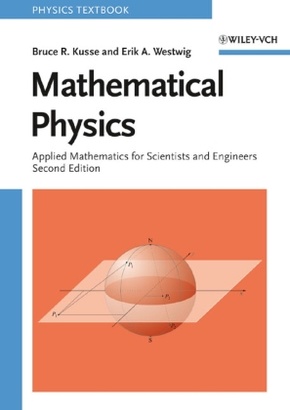Mathematical Physics - Applied Mathematics for Scientists and Engineers
| Verlag | Wiley-VCH |
| Auflage | 2006 |
| Seiten | 678 |
| Format | 17,0 x 24,1 x 3,2 cm |
| Gewicht | 1238 g |
| Artikeltyp | Englisches Buch |
| ISBN-10 | 3527406727 |
| EAN | 9783527406722 |
| Bestell-Nr | 52740672A |
Hier wird Mathematik nicht um ihrer selbst willen betrieben, sondern auf eine Vielzahl von Problemen aus dem physikalisch-technischen Umfeld angewendet! Eine Palette durchaus anspruchsvoller Themen wird - ergänzt durch zahlreiche Abbildungen und Beispiele - verständlich dargestellt, wobei die Autoren auf entbehrliche formale Beweise verzichten. Neu in dieser zweiten Auflage ist ein Anhang zur Variationsrechnung.
Übungsaufgaben befinden sich am Ende jedes Kapitels. Dozenten können die Lösungen kostenlos unter www.wiley-vch.de/textbooks/ erhalten.
Rezension:
"Insgesamt ist das Buch allen Studierenden zu empfehlen, die über den Tellerrand eines mathematischen Grundkurses hinausgehen wollen und gleichzeitig physikalische Motivationen suchen."
Physik Journal
Januar 2008
The second edition of this successful text, provides a comprehensive treatment on the mathematical methods used in physics and engineering. Covering intermediate and advanced material in a manner appropriate for undergraduate students with emphasis on the mathematical tools commonly used by scientists and engineers to solve real-world problems.
What sets this volume apart from other mathematics texts is its emphasis on mathematical tools commonly used by scientists and engineers to solve real-world problems. Using a unique approach, it covers intermediate and advanced material in a manner appropriate for undergraduate students. Based on author Bruce Kusse's course at the Department of Applied and Engineering Physics at Cornell University, Mathematical Physics begins with essentials such as vector and tensor algebra, curvilinear coordinate systems, complex variables, Fourier series, Fourier and Laplace transforms, differential and integral equations, and solutions to Laplace's equations. The book moves on to explain complex topics that often fall through the cracks in undergraduate programs, including the Dirac delta-function, multivalued complex functions using branch cuts, branch points and Riemann sheets, contravariant and covariant tensors, and an introduction to group theory. This expanded second edition contains a n ew appendix on the calculus of variation -- a valuable addition to the already superb collection of topics on offer.
This is an ideal text for upper-level undergraduates in physics, applied physics, physical chemistry, biophysics, and all areas of engineering. It allows physics professors to prepare students for a wide range of employment in science and engineering and makes an excellent reference for scientists and engineers in industry. Worked out examples appear throughout the book and exercises follow every chapter. Solutions to the odd-numbered exercises are available for lecturers at www.wiley-vch.de/textbooks/.

